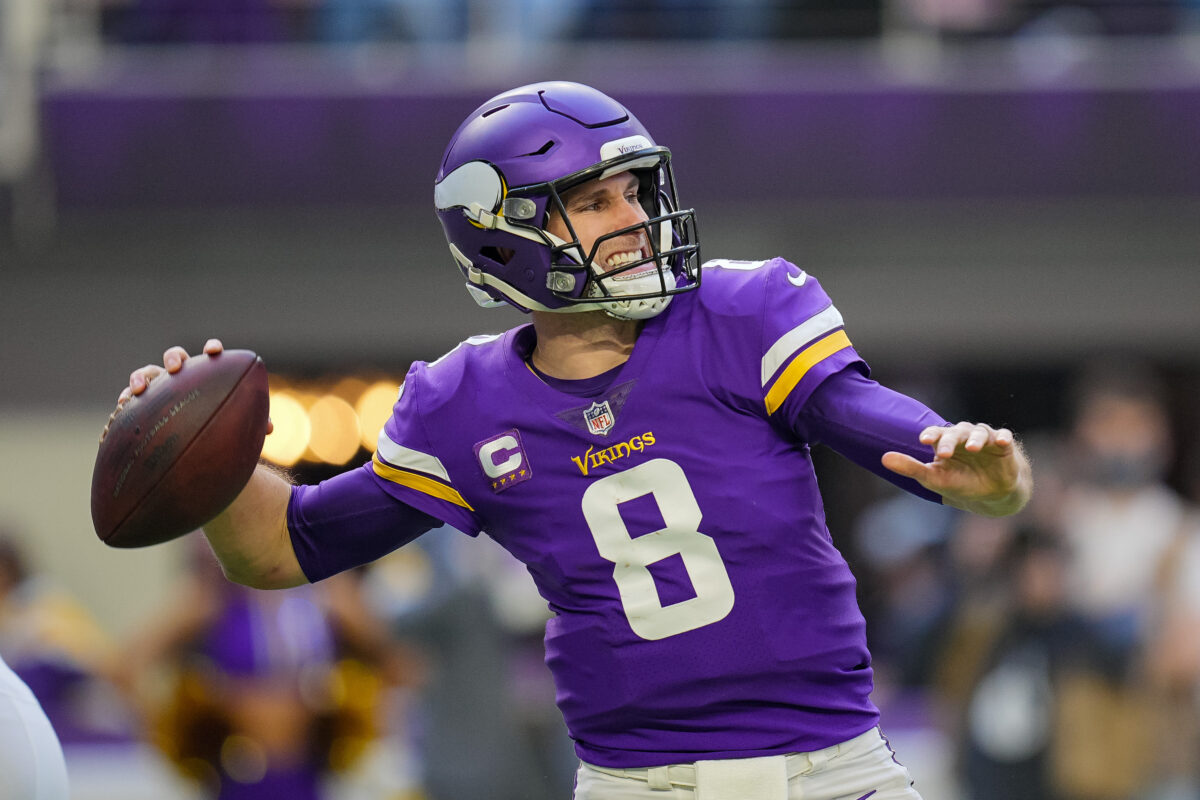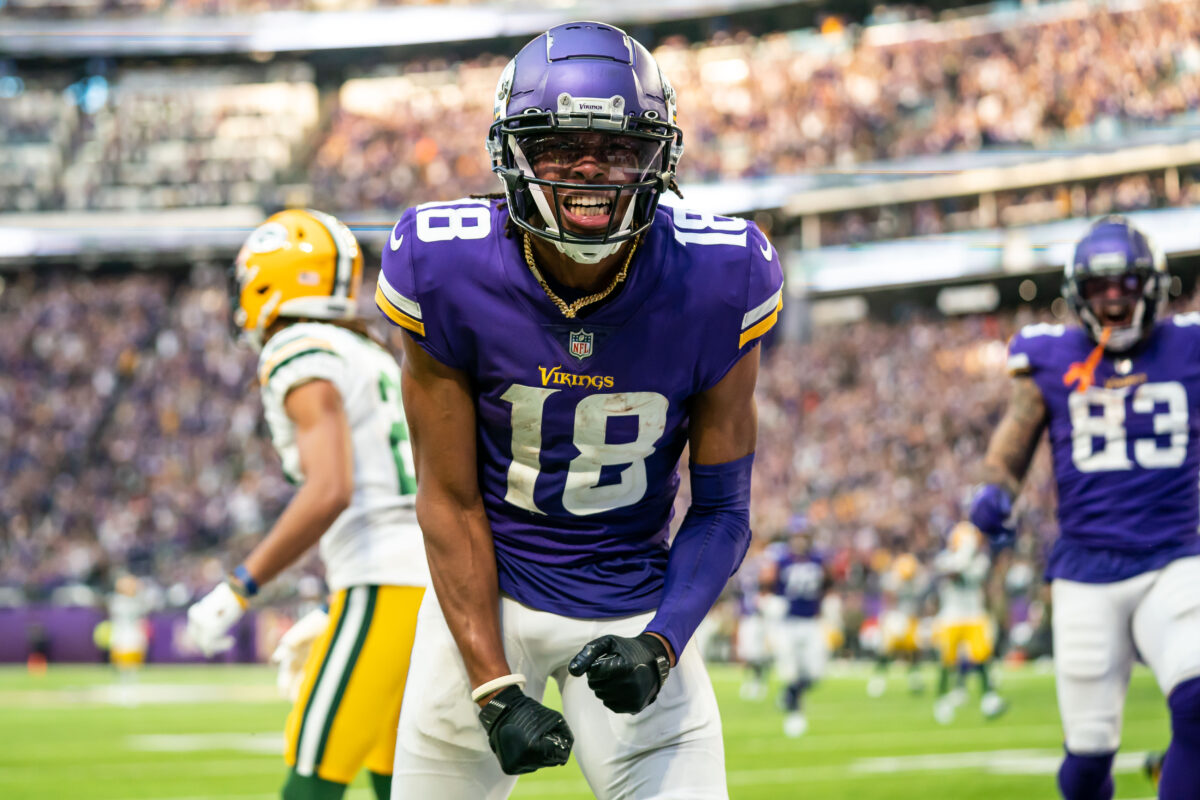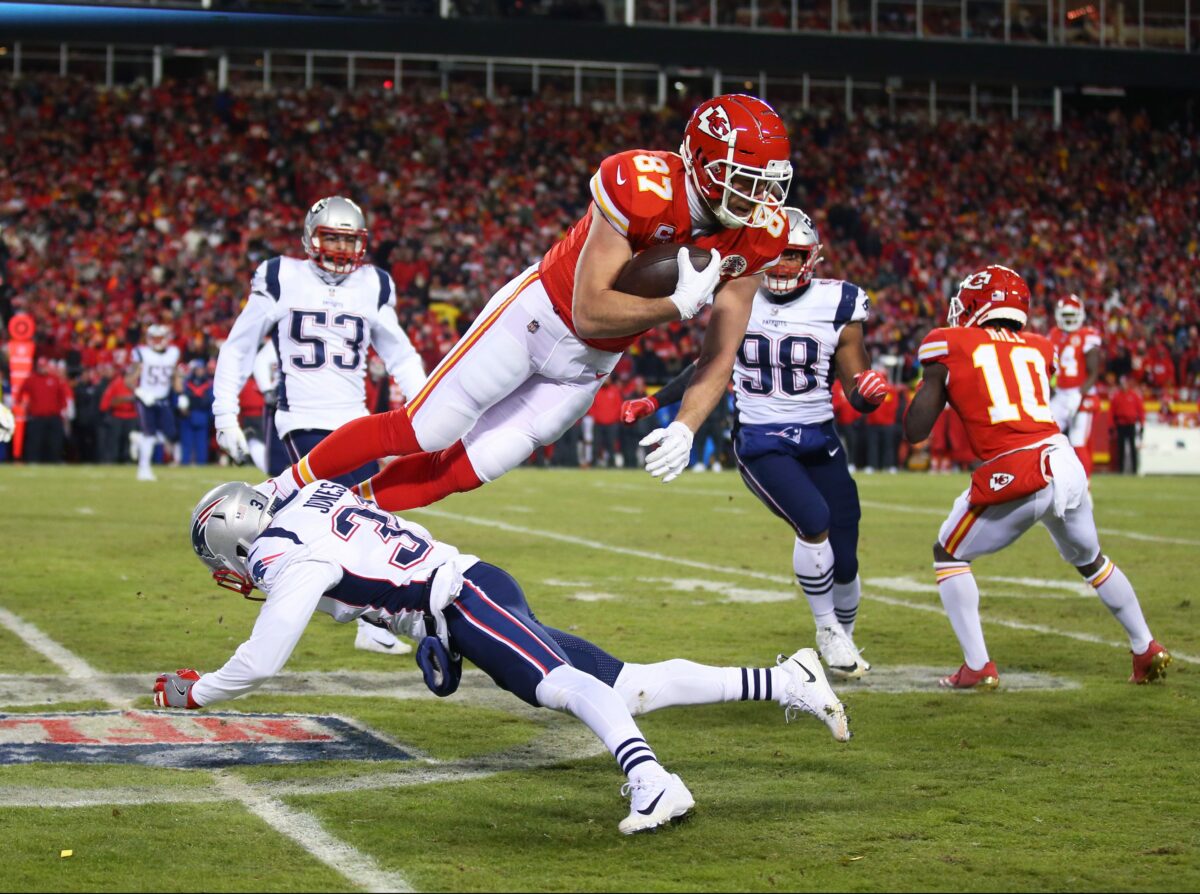The first three picks define your team and set up the rest of your draft. The optimal team is built by understanding the nuances of a scoring system and how it fits into your league rules.
A 10-team league means positional quality lasts longer. Everyone has a “good” team, so you need less depth and more difference-makers.
To follow are sample three-round drafts for 10-team fantasy football leagues. They use either standard performance scoring, performance plus a point per reception, or “2QB/Super Flex” leagues where you can start two of any position. Those three formats cover almost all leagues.
The names are less important than the positions because each draft slot has its own unique situation. Just as important are your future picks and what you need after three rounds. Rankings can change daily so these may not exactly match rankings.
Performance scoring league

Performance scoring without reception points means that running backs are at a premium, and quarterbacks are a bit more valuable. Wide receivers and tight ends are devalued but are still usually four starters in a fantasy football league. Most teams will look to get two running backs in their first three picks, and it’s hard to argue against that logic.
Team 1: RB Jonathan Taylor, RB D’Andre Swift, WR Davante Adams
Standard start for no reception points. Smaller league size allows D’Andre Swift to fall to the end of the second round, which was too tempting to let slide past. Still reached the No. 5 wideout for an advantage at WR1. A strong opening allows best-available picks regardless of position. Wide receiver, running back and quarterback are all considerations for the next handful of picks.
Team 2: RB Derrick Henry, WR Deebo Samuel, RB Travis Etienne
Like Team 1, this size league allows for a strong start of two running backs and a top wideout. Hunt for best value the rest of the way.
Team 3: RB Austin Ekeler, RB Leonard Fournette, WR Stefon Diggs
Slightly deeper than Team 2, it makes more sense to double up on running backs first, then take a higher-ranked wide receiver since, by this point, the top half of starting running backs are ending. Free to take from any position that appeals the most.
Team 4: RB Christian McCaffrey, TE Travis Kelce, RB Devin Singletary
Christian McCaffrey is less valuable without reception points but looks great on the roster, along with Travis Kelce who is less valuable in this format but still an advantage all the same. Two straight wideouts should get some balance for the starters.
Team 5: RB Nick Chubb, RB Alvin Kamara, RB Aaron Jones
This isn’t as risky as it may seem. Locked up starting running backs and the flex for the strength of the roster. Better quality wideouts and a quarterback last longer in this smaller draft and better quality players in later rounds compared to a 12-team league. But the next three picks have to consider two wideouts, and probably a quarterback or the non-RB positions will be a liability.
Team 6: RB Joe Mixon, RB Saquon Barkley, WR Mike Evans
The RB-RB start mid-draft works well when a Mike Evans or CeeDee Lamb last into the middle of the third round. But starting with the No. 6 RB, then the No. 12 RB misses out on a top-tier running back and settles for a riskier Barkley who has upside to be sure, but this team becomes very average if he repeats either of the last two years. Wideouts are up next, but prudent to take that RB3 earlier than later to cover the risk of the RB2.
Team 7: RB Dalvin Cook, WR Justin Jefferson, QB Josh Allen
With running backs so valuable and going so fast, it may seem to be just following the crowd with the seventh-straight taken as the RB1. But also prudent knowing that skipping the position would have likely left no better than the No. 12 running back for a RB1 which hurts. But went with the No. 3 wideout and even snapped up the best quarterback at the 3.07 for advantages in both positions. Should consider two running backs and a wideout over the next three picks.
Team 8: WR Ja’Marr Chase, RB Ezekiel Elliott, WR CeeDee Lamb
Opted to finally take a non-running back and went with a top receiver in the scoring system. Has the No. 11 running back for their RB, which isn’t ideal, but ends up with two of the Top-8 wideouts for an advantage at the position. Won’t need to bother with any more wide receivers for four to six rounds and must start mining for running backs and deciding when a quarterback is their best value.
Team 9: RB Najee Harris, RB James Conner, RB Antonio Gibson
The only real advantage with this plan is a strong RB2, and the other positions will have higher quality last longer in the ten-team league. But now wide receivers are a need pick in at least two of the next three rounds and needs to land a sleeper or two in order to remain above average.
Team 10: WR Cooper Kupp, RB J. Williams, QB Patrick Mahomes
That final pick of the first round grabbed the No. 2 wideout and the No. 9 running back, knowing that leaving RB1 to the end of the third-round would mean a weak spot in the starters. Grabbing Patrick Mahomes as the second quarterback taken offers a difference-maker in a high-scoring position. The running backs won’t be the best unit in the league to be sure, but at least quarterback and wide receiver are headed by top players. Probably should alternate running back and wideouts for the next four rounds.
Reception-point league

This style of scoring boosts the value of wide receivers and elite tight ends and slightly devalues quarterbacks relative to other positions. Running backs are popular in any scoring scenario but the added reception point means the position becomes deeper with third-down backs able to offer “start-able” fantasy value. The consistency of an above-average running back is also a very valuable contributor to the weekly fantasy score.
With a reception point and only ten teams, your roster should look very strong after three picks. All positions are deep in this format.
Team 1: RB Jonathan Taylor, WR CeeDee Lamb, TE Mark Andrews
This is a good use of the first pick. Top running back, solid WR1 with upside and a top tight end. The running backs will be thinning in the fourth round but still offer up Antonio Gibson, Cam Akers, and maybe Breece Hall. Running back will be a need pick with two in the next four picks, but tight end is locked up, and high-quality wideouts remain.
Team 2: RB Austin Ekeler, RB Alvin Kamara, WR Tyreek Hill
Standard start for the No. 2 drafter and smaller rosters meant that Alvin Kamara, Saquon Barkley, James Conner and the like are still there in the fourth. Can still reach a Top-10 wideout with the third pick. A couple of wideouts and another running back make sense in the next three rounds.
Team 3: RB C. McCaffrey, RB Javonte Williams, RB James Conner
This plan feels so safe – and maybe too safe, but the higher quality later in the smaller draft means it can still work. There’s no pressing need to think about another running back for at least four to six more rounds while the core of the starters are taken.
Team 4: RB Derrick Henry, WR Mike Evans, RB Saquon Barkley
Went with the No. 4 running back, but Derrick Henry could be No. 1. Mike Evans offers a solid WR1 and still reached Saquon Barkley (or Leonard Fournette) with the third pick. That made more sense because the quality of wideout will be better at the 4.07 than would be running back. Upside start but the risk of Barkley would be best served by taking RB3 in the next couple of rounds.
Team 5: WR Cooper Kupp, WR Deebo Samuel, RB Leonard Fournette
This mid-draft plan works better in the smaller ten-team draft since it nets two Top-6 wideouts which is huge in this scoring format. And still allows for Leonard Fournette or Ezekiel Elliott at RB1. Need to consider running backs in two of the next three picks.
Team 6: RB Najee Harris, RB D’Andre Swift, RB Ezekiel Elliott
This is a workable plan like Team 3 that also went RB-RB-RB. It also looks like a drafter who is used to 12-Team drafts and are amazed at finding decent starting running backs in the third round. Mine those wideouts maybe the next three or four rounds and consider a quarterback starting in Round 7 or so.
Team 7: WR Justin Jefferson, RB Nick Chubb, WR Keenan Allen
The running backs are getting thinner, so this plan works with two top wideouts and a legitimate RB1 to start. Wide receivers can wait for several rounds while a couple more running backs are added, and the quarterback and tight end start to be taken. But the safest play remains taking two more running backs in the next two picks.
Team 8: RB Joe Mixon, WR Davante Adams, WR Michael Pittman Jr.
No different from Team 7 other than a better RB1 and a worse WR1. Has to consider running backs next and can wait on that WR3 for several rounds.
Team 9: WR Ja’Marr Chase, RB Dalvin Cook, RB David Montgomery
A Top-3 wideout is an advantage with reception points and then went RB-RB as a safe pick. That meant both running backs are Top-16 (so slightly above average). Not much splash after Chase was taken, but running backs are not a liability here. Should consider wide receivers mostly in the next three picks with a third running back or even a quarterback as an option.
Team 10: TE Travis Kelce, WR Stefon Diggs, RB Travis Etienne
That final pick of the first round always tries to make up ground in different ways and it is a brilliant plan rather than just following well-established runs. Top right end, top wideout, and high-upside Travis Etienne (or Breece Hall) takes a risk to make up ground. Next pick could go anywhere, but RB2 here would get Hall or Devin Singletary. About as strong as a start as the final pick can hope to create.
QB-heavy/Super-Flex league

This sort of league will seed quarterbacks in varying measures depending on how and why quarterbacks are so valuable. The most common is the ability to start two quarterbacks, which change drafts significantly.
It will extend the quality of running backs and wideouts deeper into the draft since quarterbacks fly off the shelves far earlier than usual. This sample draft assumes two quarterbacks start and that about half of the available starters are taken by the third round.
Viewing the previous year’s results are best for this sort of starting rule because quarterbacks can go slower – or much faster – than what this draft assumes. Keep up with the other picks in the league to make sure you don’t get stuck at the end of a run on quarterbacks.
In a smaller 10-team league with additional valuable players from the quarterback boost, almost every fantasy team looks great so taking elite players is paramount to winning – get your starters before worrying about depth.
Team 1: QB Josh Allen, WR Ja’Marr Chase, QB Matthew Stafford
That first pick in the draft yet again gains a benefit. Has the best quarterback and second-best wide receiver. Then still reached the No. 11 quarterback to lock up the starting quarterbacks. Has to think running backs and maybe a wide receiver over the next three or four rounds.
Team 2: RB Jonathan Taylor, QB Tom Brady, RB Dalvin Cook
Strong start for running backs and Tom Brady is a decent QB1. By the time the 4.10 rolls around, WR1 might be Amon-Ra St. Brown or Adam Thielen. But has to take two wideouts in the next three or four rounds and still think quarterback before QB2 gets too risky.
Team 3: QB Patrick Mahomes, WR Justin Jefferson, RB Nick Chubb
This team went with a safer route – started with a great QB1, then still reached the No. 3 WR. Instead of taking Russell Wilson as a QB2, went safe with the No. 8 running back for RB1. Balanced opening, that should consider quarterback and running back next, and then just best available to fill out the other starters.
Team 4: QB Justin Herbert, RB Joe Mixon, QB Russell Wilson
Starting with QB1 makes sense at the 1.04, and the doubling down at the 3.04 created one of the better tandems of quarterbacks that sandwich the No. 6 running back as the RB1. Best path is likely three straight wideouts interrupted with an RB3 before the sixth round. But this plan honors the 2QB format without sacrificing other positions much.
Team 5: RB Austin Ekeler, QB Kirk Cousins, RB D’Andre Swift
Middle of the draft starts with the No. 2 running back and still reaches Kirk Cousins for QB1. Went with D’Andre Swift for two Top-10 running backs. The backfield can be ignored for the next few rounds that have to net a couple of wide receivers and a second quarterback. Strong start with RB1 but then average for the next two picks. Middle-round drafter needs to avoid an all-average team.
Team 6: RB Christian McCaffrey, QB Jalen Hurts, WR Stefon Diggs
Have to like what this plan attempts. Christian McCaffrey is a Top-3 running back, and then a Top-8 quarterback to prevent a liability. Taking the No. 4 wideout is a solid WR4 though receivers tend to last far longer in this format. Has to consider running backs and a quarterback for the next three rounds or so, unless a wideout falls too far to ignore.
Team 7: WR Cooper Kupp, RB Najee Harris, QB Aaron Rodgers
This is what happens when a quarterback is not taken in the first two rounds. It can still work, so long as the early picks in other positions are elite performers. Certainly the top wide receiver and No. 5 running back are hot starts, but that only leaves the No. 13 quarterback as QB1. Must consider a QB2 in the next two picks which would be no better than Ryan Tannehill or Matt Ryan.
Team 8: QB Joe Burrow, RB Derrick Henry, QB Trey Lance
This looks promising. No. 4 quarterback at QB1 and the No. 4 running back for RB1. That critical third pick accessed Trey Lance in this draft for high upside and yet plenty of risk. Could have been Derek Carr or Trevor Lawrence. This is sort of a generic approach in Super Flex leagues, with that middle pick as the most enticing running back, tight end or wide receiver. The next four rounds or more have to consider either a running back or a wideout.
Team 9: TE Travis Kelce, QB Lamar Jackson, RB Javonte Williams
Started with a big advantage at tight end and still reached the No. 7 quarterback for QB1. Snapping up Javonte Williams (or Alvin Kamara or James Conner) provided a low-end at RB1 but the team also picks at the 4.02 in just two turns. Davante Adams or Deebo Samuel make a great WR1 and a very solid beginning. Wideouts and running backs should dominate the next five or six rounds.
Team 10: QB Dak Prescott, QB Kyler Murray, RB Alvin Kamara
Drafting at the end of the first round is far less challenging than in a regular league that only starts one quarterback. Those drafts typically wait for around the seventh or eighth round for team owners to recall they want a quarterback. In this, doubling down on the No. 5 and No. 6 quarterbacks made for a powerful start, and the No. 11 running back can still have upside. The 4.01 can be Saquon Barkley or Davante Adams or Mark Andrews. Certainly running back has to make up two of the next five picks, but two high-scoring quarterbacks spitting out weekly points allows for more risk-tolerance on the other starters.














